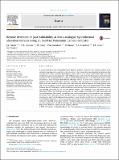Remote detection of past habitability at Mars-analogue hydrothermal alteration terrains using an ExoMars Panoramic Camera emulator
Abstract
A major scientific goal of the European Space Agency’s ExoMars 2018 rover is to identify evidence of life within the martian rock record. Key to this objective is the remote detection of geological substrates that are indicative of past habitable environments, which will rely on visual (stereo wide-angle, and high resolution images) and multispectral (440–1000 nm) data produced by the Panoramic Camera (PanCam) instrument. We deployed a PanCam emulator at four hydrothermal sites in the Námafjall volcanic region of Iceland, a Mars-analogue hydrothermal alteration terrain. At these sites, sustained acidic–neutral aqueous interaction with basaltic substrates (crystalline and sedimentary) has produced phyllosilicate, ferric oxide, and sulfate-rich alteration soils, and secondary mineral deposits including gypsum veins and zeolite amygdales. PanCam emulator datasets from these sites were complemented with (i) NERC Airborne Research and Survey Facility aerial hyperspectral images of the study area; (ii) in situ reflectance spectroscopy (400–1000 nm) of PanCam spectral targets; (iii) laboratory X-ray Diffraction, and (iv) laboratory VNIR (350–2500 nm) spectroscopy of target samples to identify their bulk mineralogy and spectral properties. The mineral assemblages and palaeoenvironments characterised here are analogous to neutral–acidic alteration terrains on Mars, such as at Mawrth Vallis and Gusev Crater. Combined multispectral and High Resolution Camera datasets were found to be effective at capturing features of astrobiological importance, such as secondary gypsum and zeolite mineral veins, and phyllosilicate-rich substrates. Our field observations with the PanCam emulator also uncovered stray light problems which are most significant in the NIR wavelengths and investigations are being undertaken to ensure that the flight model PanCam cameras are not similarly affected.
Citation
Harris , J K , Cousins , C R , Gunn , M , Grindrod , P M , Barnes , D , Crawford , I A , Cross , R E & Coates , A 2015 , ' Remote detection of past habitability at Mars-analogue hydrothermal alteration terrains using an ExoMars Panoramic Camera emulator ' , Icarus , vol. 252 , pp. 284-300 . https://doi.org/10.1016/j.icarus.2015.02.004
Publication
Icarus
Status
Peer reviewed
ISSN
0019-1035Type
Journal article
Description
JKH is funded by a Birkbeck University of London Graduate Teaching Assistantship. CRC is funded by a Royal Society of Edinburgh Personal Research Fellowship co-funded by Marie Curie Actions. The Aberystwyth research leading to these results has been funded by the UK Space Agency, ExoMars Panoramic Camera (PanCam) Grant Nos. ST/G003114/1, ST/I002758/1, STL001454/1, and the UK Space Agency CREST2 PanCam-2020 research Grant No. ST/L00500X/1. Additional Aberystwyth funding has come from The European Community’s Seventh Framework Programme (FP7/2007-2013), Grant Agreement Nos. 21881 PRoVisG, 241523 PRoViScout, and Grant Agreement No. 312377 PRoViDE. PMG is funded by a UK Space Agency Aurora Fellowship (grants ST/J005215/1 and ST/L00254X/1).Collections
Items in the St Andrews Research Repository are protected by copyright, with all rights reserved, unless otherwise indicated.

